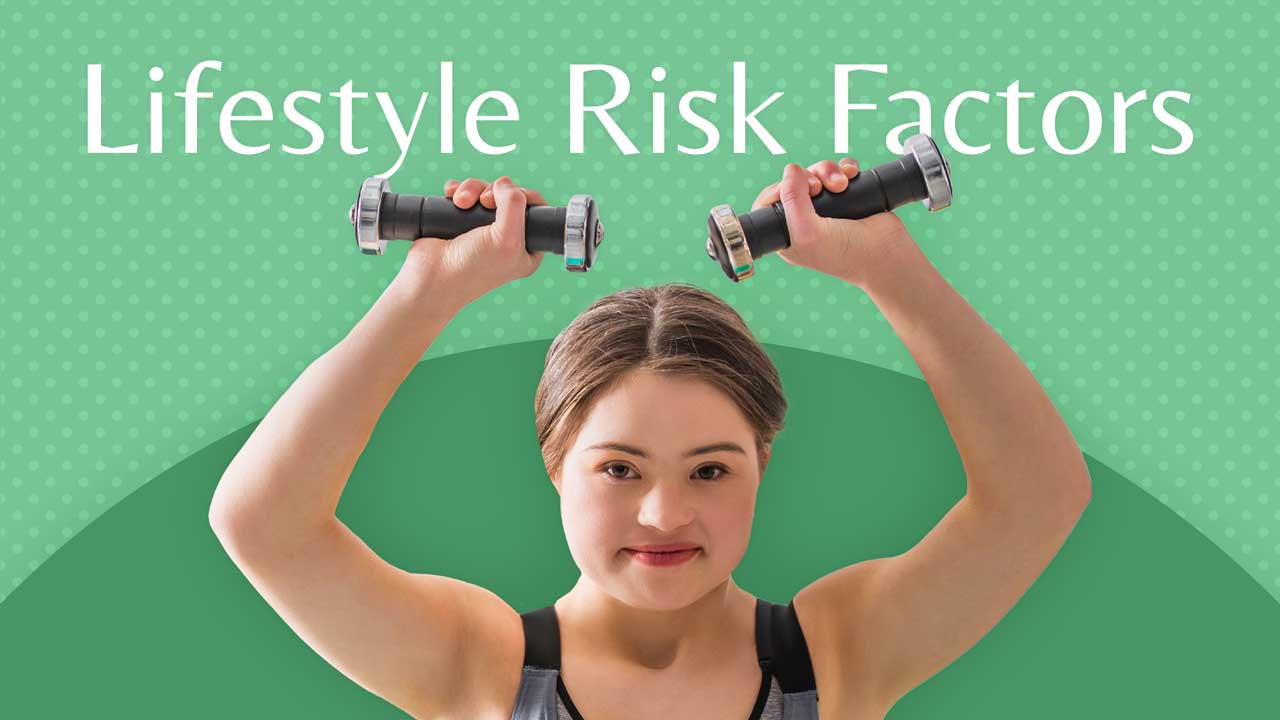People living with disability are 3.6 times more likely to die from a potentially preventable cause than the general population (AIHW 2020), partially due to a lack of preventative healthcare measures being taken for people with disability (Salomon & Trollor 2019).
However, in addition to proactively addressing health risks in people with disability, health issues and potential deaths can also be reduced in these populations by modifying lifestyle risk factors (AIHW 2024a).
It’s been found that people living with disability in Australia display higher rates of certain modifiable lifestyle risk factors than the general population (AIHW 2024a).
This is likely because people living with disability may face specific challenges that make it more difficult to modify these risk factors - for example, a person with a physical disability may require extra assistance to maintain regular physical activity (AIHW 2024a).
For this reason, NDIS providers and workers need to have awareness and knowledge of how the serious injury and death of people with disability can be prevented, including the importance of addressing lifestyle risk factors in people with disability.
What are Lifestyle Risk Factors?
Lifestyle risk factors are modifiable attributes, characteristics or exposures that may increase the risk of developing illnesses and health issues, or exacerbate existing health problems (ACSQHC & NDIS Commission 2021; AIHW 2024a).
Changing or modifying these risk factors can improve the overall health of an individual, as well as reduce the risk of illness or death (ACSQHC & NDIS Commission 2021; AIHW 2024a).
There are two types of lifestyle risk factors:
- Behavioural risk factors are actions that individuals can directly modify
- Biomedical risk factors are potentially harmful bodily states that can be influenced by behaviours but are also associated with genetic, socioeconomic and psychological factors.
(AIHW 2024a)

Examples of lifestyle risk factors include:
| Behavioural | Biomedical |
|---|---|
|
|
(AIHW 2024b; ACSQHC & NDIS Commission 2021)
Consequences of Lifestyle Risk Factors
Lifestyle risk factors are associated with a variety of health issues, including but not limited to:
- Cardiovascular disease
- Stroke
- Type 2 diabetes
- Musculoskeletal disorders
- Cancers
- Chronic kidney disease
- Mental illness and substance use disorders
- Respiratory diseases
- Dementia.
(AIHW 2024c)

Lifestyle Risk Factors in People With Disability
People with disability are more likely than the general population to experience certain physical and mental health conditions that could be caused or exacerbated by lifestyle risk factors. These include cardiovascular disease, respiratory disease, cancer, diabetes, oral diseases, depression and anxiety (ACSQHC & NDIS Commission 2021).
They are also more likely to have lifestyle risk factors than the general population. For example, in Australia:
- 74% of people with disability are inactive (compared to 71% of the general population)
- 55% of people with disability do not consume an adequate amount of fruits and vegetables (compared to 51% of the general population)
- 8.3% of people with disability consume sugar-sweetened drinks daily (compared to 5.6% of the general population)
- 14% of people with disability smoke daily (compared to 9.1% of the general population).
(AIHW 2024a)
Barriers to Addressing Lifestyle Risk Factors
There are a variety of reasons why people with disability may find it more difficult than the general population to modify certain behavioural lifestyle risk factors:
| Lifestyle factor | Potential barriers |
|---|---|
| Healthy diet |
|
| Exercise and physical activity |
|
| Alcohol, smoking and substance abuse |
|
| Social connectedness |
|
(Gadsby & Jones 2016; AIHW 2024a; ACSQHC & NDIS Commission 2021)
Supporting People to Address Lifestyle Risk Factors

With the above barriers in mind, how can people living with disability be supported to optimise their health and wellbeing and reduce lifestyle risk factors?
- Support people to set achievable small goals and slowly work their way up (e.g. not having sugar in their coffee)
- Facilitate connection with others by encouraging people to participate in community and local activities that promote a healthy lifestyle (e.g. cooking classes, walking groups, a community garden)
- Use health promotion to help people better understand the importance of a healthy lifestyle
- Support people to make informed decisions about their own lifestyle, including helping them to understand any current health risks and how they can be addressed
- Increase people’s motivation to maintain a healthy lifestyle by encouraging them and highlighting their achievements
- Suggest a variety of ideas for improving health, e.g. learning to cook or walking instead of driving
- Support people to make changes to their living environments (e.g. increasing the number of healthy foods in their cupboard)
- Support people to access health professionals such as dietitians and physiotherapists who can help them achieve their health goals
- Ensure people undergo an annual comprehensive health assessment.
(ACSQHC & NDIS Commission 2021)
Test Your Knowledge
Question 1 of 3
How much more likely are people with disability to die from a potentially preventable cause compared to the general population?
Topics
Further your knowledge
References
- Australian Commission on Safety and Quality in Health Care & NDIS Commission 2021, Practice Alert: Lifestyle Risk Factors, Australian Government, viewed 13 May 2025, https://www.ndiscommission.gov.au/sites/default/files/2022-05/practice-alert-lifestyle-risk-factors.pdf
- Australian Institute of Health and Welfare 2020, Mortality Patterns Among People Using Disability Support Services: 1 July 2013 to June 2018, Australian Government, viewed 13 May 2025, https://www.aihw.gov.au/reports/disability/mortality-patterns-of-people-using-disability-serv/contents/summary
- Australian Institute of Health and Welfare 2024a, People With Disability in Australia: Health Risk Factors and Behaviours, Australian Government, viewed 13 May 2025, https://www.aihw.gov.au/reports/disability/people-with-disability-in-australia/contents/health/health-risk-factors-and-behaviours
- Australian Institute of Health and Welfare 2024b, Biomedical Risk Factors, Australian Government, viewed 13 May 2025, https://www.aihw.gov.au/reports/australias-health/biomedical-risk-factors
- Australian Institute of Health and Welfare 2024c, Australian Burden of Disease Study 2024: Diseases and Associated Risk Factors, Australian Government, viewed 13 May 2025, https://www.aihw.gov.au/reports/burden-of-disease/australian-burden-of-disease-study-2024/contents/interactive-data-on-risk-factor-burden/diseases-and-associated-risk-factors
- Gadsby, D & Jones, P 2016, Disability and Health Behaviours: Health Behaviours Joint Strategic Needs Assessment Literature Review, Lancashire County Council, viewed 14 May 2025, https://www.lancashire.gov.uk/media/899798/disability-and-health-behaviours-updated-links-oct-2016.pdf
- Salomon, C & Trollor, J 2019, A Scoping Review of Causes and Contributors to Deaths of People With Disability in Australia: Summary of Key Findings, Department of Developmental Disability Neuropsychiatry University of New South Wales, viewed 13 May 2025, https://www.ndiscommission.gov.au/sites/default/files/2024-09/summary-findings-24.pdf
 New
New 

